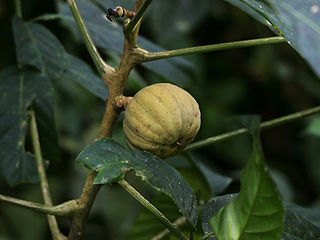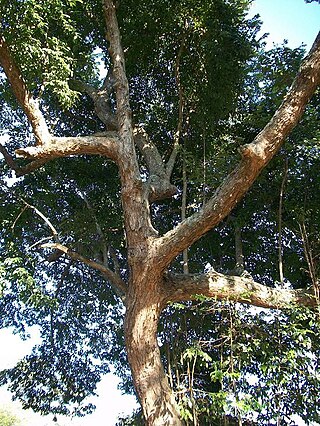
Amanoa is a genus from the family Phyllanthaceae first described as a genus in 1775. It is native to South America, Central America, the West Indies, and tropical Africa.

Phyllanthaceae is a family of flowering plants in the eudicot order Malpighiales. It is most closely related to the family Picrodendraceae.
Celianella is a genus of plants belonging to the family Phyllanthaceae first described in 1965. It has only one known species, Celianella montana, native to Guyana and to southern Venezuela. It is dioecious, with male and female flowers on separate plants.
Wielandia is a genus of flowering plant, of the family Phyllanthaceae first described as a genus in 1858. The plants are native to Kenya, Madagascar, and to various other islands in the Indian Ocean.
Tacarcuna is a genus of plants in the Phyllanthaceae first described as a genus in 1989. It is native to Panama, Colombia, Venezuela, and Peru. It is apparently dioecious, with male and female flowers on separate plants.
- Tacarcuna amanoifoliaHuft - Loreto Region in Peru; Amazonas Department in Colombia
- Tacarcuna gentryiHuft - Darién Province in Panama, Magdalena Department in Colombia
- Tacarcuna tachirensisHuft - Táchira State in Venezuela
Caryodendron is a plant genus of the family Euphorbiaceae first described as a genus in 1860. The genus includes C. orinocense, known as the Inchi tree or Tacay nut. It is native to Central America and South America. They are dioecious trees.
- Caryodendron amazonicumDucke - Amazonas in Brazil
- Caryodendron angustifoliumStandl. - Costa Rica, Panama, Colombia
- Caryodendron janeirenseMüll.Arg. - Rio de Janeiro
- Caryodendron orinocenseH.Karst - Colombia, Venezuela, Ecuador

Caperonia is a genus of plants of the family Euphorbiaceae first described as a genus in 1825. The genus is native to tropical and subtropical America and Africa.

Acidoton is a genus of plant of the family Euphorbiaceae first described as a genus in 1788. It is native to the Greater Antilles, Central America, and tropical South America.

Hura is a genus of trees in the family Euphorbiaceae described by Carl Linnaeus in 1753. It is native to South America, Mesoamerica, and the West Indies.
Leptonema is a genus of flowering plant belonging to the family Phyllanthaceae first described in 1824. The entire genus is endemic to Madagascar. It is dioecious, with male and female flowers on separate plants.
- Leptonema glabrum(Leandri) Leandri
- Leptonema venosum(Poir.) A.Juss.
Ashtonia is a genus of flowering plant belonging to the family Phyllanthaceae first described as a genus in 1968. It is native to the Malay Peninsula and Borneo. It is dioecious, with male and female flowers on separate plants.
- Ashtonia excelsa Airy Shaw - Borneo
- Ashtonia praeterita Airy Shaw - S Thailand, W Malaysia
Astrocasia is a plant genus of the family Phyllanthaceae first described as a genus in 1905. It is included in the subtribe Astrocasiinae. It is native to Mesoamerica, northern South America, and the western part of the West Indies. Plants are mostly dioecious, except for Astrocasia diegoae which is monoecious, and some individuals of A. neurocarpa and A. tremula.
- Astrocasia austinii(Standl.) G.L.Webster - Izabal
- Astrocasia diegoaeJ.Jiménez Ram. & Mart.Gord. - Guerrero
- Astrocasia jacobinensis(Müll.Arg.) G.L.Webster - Bahia, Bolivia
- Astrocasia neurocarpa(Müll.Arg.) I.M.Johnst. ex Standl. - Oaxaca, Querétaro, San Luis Potosí, Tamaulipas
- Astrocasia peltataStandl. - Costa Rica, Nayarit, Jalisco
- Astrocasia tremula (Griseb.) G.L.Webster - Mexico, Central America, West Indies, northern South America

Margaritaria is a plant genus of the family Phyllanthaceae first published as a genus in 1782. It is the smallest pantropical genus of the Phyllanthaceae and, formerly, of the Euphorbiaceae, widely distributed in tropical and subtropical regions of Asia, Africa, Australia, North and South America, and various oceanic islands.
Chonocentrum is a genus of the family Phyllanthaceae described as a genus in 1922. It contains only known species, Chonocentrum cyathophorum, native to the State of Amazonas in northwestern Brazil.
Discocarpus is a genus of the plant family Phyllanthaceae first described as a genus in 1841. It is native to northern South America. It is dioecious, with male and female flowers on separate plants.
- Discocarpus essequeboensisKlotzsch - Brazil, Venezuela (Amazonas), Guyana, Suriname, French Guiana
- Discocarpus gentryiS.M.Hayden - S Venezuela (Amazonas), Peru (Loreto), N Brazil
- Discocarpus pedicellatusFiaschi & Cordeiro - State of Bahia in Brazil
- Discocarpus spruceanusMüll.Arg. - Venezuela (Amazonas), Brazil, Suriname (Sipaliwini), Bolivia

Dalechampia dioscoreifolia is a species of plant in the family Euphorbiaceae first described in 1841. It is native to Central America and northern and western South America.
João Geraldo Kuhlmann was a Brazilian botanist.

Flueggea, the bushweeds, is a genus of shrubs and trees in the family Phyllanthaceae first described as a genus in 1806. It is widespread across much of Asia, Africa, and various oceanic islands, with a few species in South America and on the Iberian Peninsula.
Croizatia is a small genus of plants in the Phyllanthaceae first described as a genus in 1952. It is native to Panama and to northwestern South America. It is dioecious, with male and female flowers on separate plants.
- Croizatia brevipetiolata(Secco) Dorr - Colombia, NW Venezuela
- Croizatia cimaloniaCerón & G.L.Webster - Ecuador
- Croizatia naiguatensisSteyerm. - N Colombia, N Venezuela
- Croizatia neotropicaSteyerm. - N Venezuela, Vaupés in E Colombia
- Croizatia panamensisG.L.Webster - Panama, NW Colombia

Pausandra is a plant genus of the family Euphorbiaceae first described in 1870. It is native to Central America and South America.
- Pausandra fordiiSecco - Amapá, French Guiana
- Pausandra hirsutaLanj. - Peru, Brazil, Bolivia (Pando), Colombia (Amazonas)
- Pausandra macropetalaDucke - Brazil, Peru (Loreto), Venezuela (Amazonas)
- Pausandra macrostachyaDucke - Pará
- Pausandra martiniBaill. - French Guiana, Suriname, Guyana, Colombia, Venezuela, Peru, Brazil
- Pausandra megalophyllaMüll.Arg. - Rio de Janeiro
- Pausandra morisiana(Casar.) Radlk. - Brazil
- Pausandra trianae(Müll.Arg.) Baill. - widespread from Honduras to Bolivia








